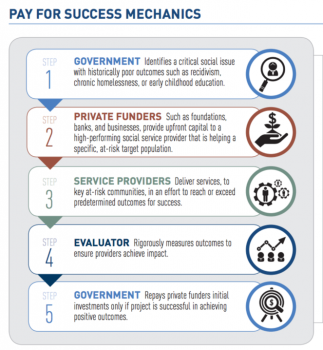By Danielle Antico
Third Sector Capital Partners is “accelerating America’s transition to a performance-driven social sector.” Well that sounds good to me, but how do they do it? As a fourth year student studying management and entrepreneurship, with a passion for social entrepreneurship, I decided to join the Third Sector team in July as their inaugural co-op to find out.
Philanthropy cannot stand alone in funding the solutions needed to combat society’s greatest challenges including poverty, homelessness, recidivism, and educational inequality. Capital markets must be accessed and business forces leveraged to catalyze scalable, measurable, and impactful change in our world. Furthermore, the social sector currently depends on government spending. Private philanthropy does not nearly match the amount of government dollars spent on social programs.
If we turn to government, we can observe many social programs that show little to no evidence of impact yet, are fully funded. The Institute for Education Sciences (IES), an organization of the U.S. Department of Education, has commissioned many randomized control trials (RCTs) to evaluate the effects of educational programs. The Coalition for Evidence-Based Policy writes that of 90 total interventions evaluated in these RCTs, only 11 programs were found to produce positive effects, with 79 programs found to produce weak or no positive effects. Millions of taxpayer dollars support programs that were presumably created with good intentions; however, these do little to lift people out of poverty, keep Americans out of jail, or to support a more robust educational system that works for all.
Instead, let’s pay for what works and divert funds away from failing programs to those that have demonstrated ability to improve lives. Third Sector Capital Partners engages stakeholders in the reallocation of government resources towards high-performing social programs through the Pay for Success model of government contracting. By measuring an intervention’s success against predetermined metrics, it can be determined whether or not that program should be funded with government dollars. These dollars constitute “success payments.”
This sounds good – pay for what works and do not pay for what is ineffective. That logic is intuitive, but it also poses a problem: How do we pay for a project in the meantime, before its success can be accurately measured over time against key metrics of bettering a person’s life? There are startup costs and program expenses that must be paid now.
This funding gap is filled by “social impact bonds” (SIBs). SIBs are not a bond in the traditional sense of the word. They are a loan from a private funder that fills the gap between deploying a project and measuring its impact. In this way, government contracts with social service providers can be bound to impact measurement, with the support of capital markets. Let’s review the entire process from the beginning.
The Pay for Success contracting model engages five key stakeholders: government, private funders, social service providers, evaluators, and a project manager (such as Third Sector). With the common goal of achieving sustainable impact for communities facing pressing challenges, these entities work together to fund, deploy, and measure a project’s success as follows:

Third Sector works in counties across the United States, and has even launched a Pay for Success project in Massachusetts. Focused on reducing recidivism among at-risk youth, the Massachusetts Juvenile Justice Pay for Success Initiative engages with service provider Roca. Roca delivers their proven intervention model addressing job readiness, educational readiness, and life skills development for high-risk young men. As Roca delivers their services over a period of time, an independent third-party evaluator and validator measure the program’s effectiveness in reducing the number of days that participants spend in prison, improving their job readiness, and increasing their employment. If predetermined benchmarks are met, the Commonwealth makes success payments to funders with the possibility of a small percentage return for higher levels of success. Over the course of seven years, Massachusetts will pay up to $28 million in success payments; this investment is the largest of its kind in the U.S. Pay for Success initiative to date.
So there you have it. By reallocating resources to programs that are proven effective, governments fund what works (they pay for success) while avoiding supporting programs that have no measurable impact on the lives of their constituents.
CEO and Co-Founder of Third Sector Capital Partners, George Overholser, will be co-teaching a course for the spring 2017 semester with Professor Sara Minard called ENTR3212: Innovation for Social Change.
Visit http://www.thirdsectorcap.org/ to learn more about Pay for Success and projects Third Sector is currently working on!


